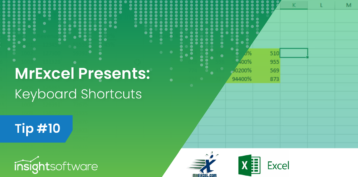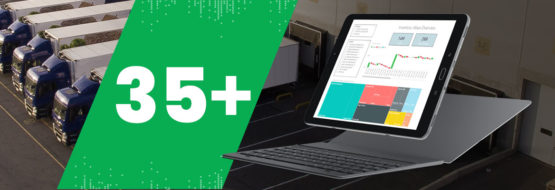Four Data Visualization Best Practices for Finance

Pictures have the capacity to tell stories in ways that raw data simply cannot. The majority of people are visual learners, able to draw conclusions far more accurately and efficiently from charts, graphs, and other dashboard elements than from large volumes of data presented in rows and columns.
It’s wonderful news, therefore, that data visualization tools have come as far as they have, providing tremendous power and flexibility that enables finance users to present compelling, meaningful information to help business leaders make better-informed decisions. It has become more important than ever, therefore, for finance professionals to develop and hone their data visualization skills.
The rise of data visualization skills is just one example of a much broader trend that has seen finance teams transform from being focused primarily on transactional control of profit and loss and cash flow to becoming a source of real strategic thinking within an organization. Finance teams today represent the center for data-driven thinking in most organizations.
Data visualizations provide an especially powerful tool for recognizing trends, spotting opportunities, and developing clear insights to help drive better business decisions. In this respect, they represent an essential tool in the finance and accounting toolbox. How can finance professionals make the most of the latest data visualization technology to tell compelling stories and encourage sound, data-driven business decisions? Here are some best practices to keep in mind as you hone your craft:
1. Know Your Audience and What Matters to Them
When you’re delivering a talk to a group of people, one of the cardinal rules is “know your audience.” That means understanding who they are, what they care about most, and perhaps just as importantly, what they don’t care about.
What are your organization’s key strategic goals? What are the metrics that distinguish high levels of performance from mediocre or low ones? Which factors most dramatically impact revenue, expenses, and cash flow? This may include factors that fall outside of management’s control, such as competitive activity, economic indicators, or even the weather. What do members of the executive management team care about, and how can you provide a window to the data that is most meaningful to them?
Knowing your audience is about understanding what matters to them and which data they want to see on a regular basis. It may also call for members of the finance team to think outside of the usual parameters and consider which data points might provide useful insights, even if they aren’t currently on management’s radar screen. The key is to pinpoint audience interest areas and assemble visualizations that answer their questions in a compelling way.
2. Focus on the Story Your Data Tells
Finance users are naturally adept at analyzing data. Generally speaking, they tend to know the numbers much better than others in the organization because they live and breathe financial information every day. It’s a natural conclusion, therefore, that the finance team is well- positioned to spot trends and see “the story” behind the data before anyone else.
Data visualization is about telling those stories, or perhaps it’s better to say that visualizations allow the data to tell its own story. Visualizations open the door for non-finance users to easily identify trends, spot anomalies, and formulate follow-up questions that enable them to understand what’s happening in the business at a deeper level.
When finance users spot something meaningful in the data, whether that is something that aligns with the organization’s strategic objectives or which falls outside of normal parameters, they should consider that it might be the seed for a powerful and meaningful visualization. Look for meaningful information, consider how that tells a compelling story, and think about how that might be rendered visually for your target audience.
3. Enhance Your Team’s Data Visualization Skills
Data visualization tools are increasingly powerful. With the right technology, you can deliver compelling real-time information about what’s happening in your business. For finance teams, this represents a golden opportunity to reinforce your role as proponents of strategic thinking and data-driven decision making.
Effective data visualizations are about far more than simply presenting financial data in a visual format. There is an art to eliciting meaningful insights from that data and presenting it in a way that helps your target audience better understand what’s happening in the business. Finance teams that actively pursue excellence in data visualization stand out as strategic thinkers and increase the value they provide to the organizations in which they operate.
4. Invest in the Right Technology
Finally, it’s important to have the right tools. While many finance teams get started with spreadsheets, desktop productivity tools come with some significant limitations. You can accomplish a great deal with a spreadsheet, but using it as a standalone tool is insufficient to the task of providing compelling real-time visualizations for executive management.
The best data visualization tools start with strong integration to enterprise resource planning (ERP) systems, providing real-time visibility to transactional data. This eliminates the need for periodic data exports and gives executives access to the most current information, allowing for substantially increased business agility.
Drill-down capabilities are also essential. When members of your target audience have questions about what they’re seeing, drill-down allows them to quickly and easily explore the detailed data behind the summary trends. This makes follow-up a self-service process. Instead of spending time and energy seeking out additional details, your audience can find the answers they need right away, without burdening the finance team with follow-up questions.
Secure distribution of reports and visualizations is critical as well. The best data visualization tools enable finance users to develop and distribute reports to a specific target audience, on a one-off basis or according to a defined schedule. A good tool should also accommodate security concerns, ensuring that information does not fall into the wrong hands.
The best data visualization tools enable finance users to develop and modify reports and dashboards without relying on technical specialists from the IT department.
insightsoftware provides powerful tools to develop reports, dashboards, and visualizations for over 140 different ERP systems. Our products put the finance team in control of the reporting process, enabling non-technical users to create, modify, and distribute reports and dashboards that support strategic insights and effective management control. To learn more about how insightsoftware can help your business, contact us today to arrange a free, no-obligation demo.






